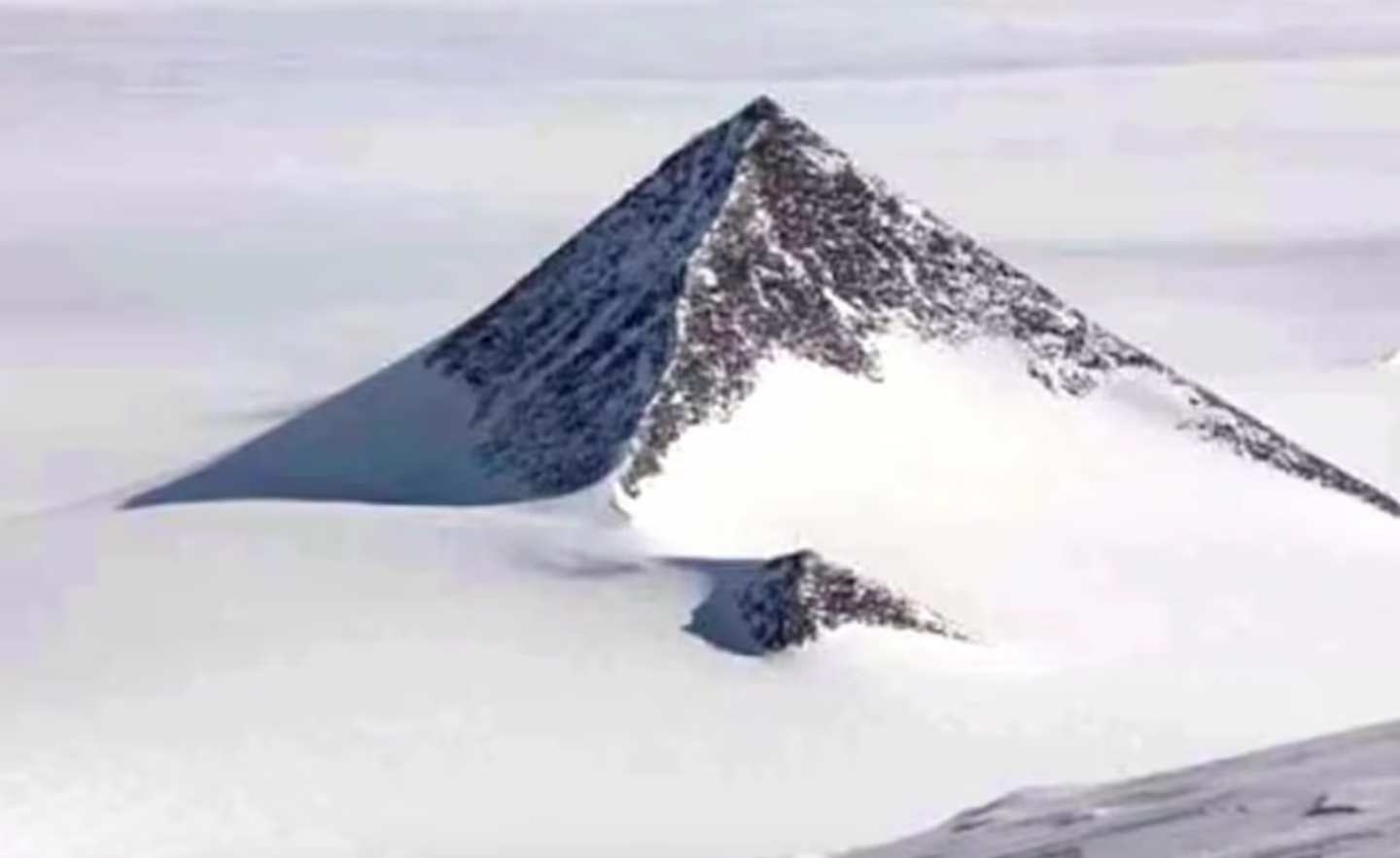Pyramid hidden for millennia discovered in Antarctica
A striking formation rises from Antarctica’s icy expanse, its sharp lines cutting through the frozen landscape like a forgotten relic.

Buried beneath layers of dense frost in the Ellsworth Mountains, this pyramid-like structure has fueled a storm of speculation. (CREDIT: CC BY-SA 4.0)
A striking formation rises from Antarctica’s icy expanse, its sharp lines cutting through the frozen landscape like a forgotten relic.
Buried beneath layers of dense frost in the Ellsworth Mountains, this pyramid-like structure has fueled a storm of speculation. Some claim it holds the key to an ancient civilization, while others see evidence of extraterrestrial design. Yet, as history shows, appearances can be deceiving.
Pyramids have long fascinated the world, their towering structures standing as testaments to civilizations of the past. Egypt, Sudan, Mexico, and Peru boast these awe-inspiring monuments, their origins shrouded in mystery.
The discovery of a similar formation in one of Earth’s most inhospitable regions raises tantalizing questions. Could an ancient society have once thrived here, hidden beneath the ice?
Recent satellite images have only deepened the intrigue. Aerial views captured by Google Earth reveal what appears to be a perfectly symmetrical peak. Its steep, angular slopes mimic the familiar shape of a pyramid, its sharp summit jutting above the tundra. To the untrained eye, the resemblance is uncanny. But does this icy monolith hold secrets, or is it simply a trick of nature?
As speculation spreads across social media, wild theories take root. Some enthusiasts insist the structure is man-made, an artifact buried by time. Others go further, weaving tales of extraterrestrial builders or lost civilizations. Images and videos fuel the frenzy, each one amplifying the mystery. But beneath the excitement, science demands a closer look.
Enter the geologists, Earth's detectives, armed with knowledge of rock formations and natural forces. Unlike the internet’s more imaginative theorists, these experts seek answers grounded in evidence.
While the shape may resemble a pyramid, its existence is not so improbable. Natural processes, such as freeze-thaw cycles and erosion, can carve mountains into remarkably geometric forms.
Related Stories
According to Professor Eric Rignot of the University of California, an expert in Earth system science, the fuss may be much ado about nothing. “This is just a mountain that looks like a pyramid," Rignot stated, aiming to allay rumors. He further elaborated, “Pyramid shapes are not impossible — many peaks partially look like pyramids, but they only have one to two faces like that, rarely four."
As per geological consensus, the structure's steep, pyramid-like sides result from hundreds of millions of years of erosion.
Dr. Mitch Darcy, an eminent geologist at the German Research Centre for Geosciences, provided further clarity, stating, “The pyramid-shaped structures are located in the Ellsworth Mountains, which is a range more than 400 km long, so it’s no surprise there are rocky peaks cropping out above the ice.” For Darcy, the rock formation’s semblance to a pyramid is a mere coincidence.
Darcy shed light on the actual nature of the 'pyramid,' explaining, “By definition, it is a nunatak, which is simply a peak of rock sticking out above a glacier or an ice sheet. This one has the shape of a pyramid, but that doesn’t make it a human construction.”
The unnamed mountain stands tall at coordinates 79°58’39.25”S 81°57’32.21”W, located in an area known as the "Heritage Range." This vicinity is not unacquainted with historic wonders. Remarkable fossils, some dating back more than 500 million years, have been discovered here. At 4,150 feet, this 'pyramid' might not be imposing compared to other mountains, but its enigmatic nature keeps people captivated.
Mauri Pelto, a professor of environmental science at Nichols College, voiced his opinions on the myriad of conspiracy theories surrounding the mountain, saying, "At least they’re thinking about something.” He optimistically added, “In the end, maybe they’ll learn something in the process."
The human mind is innately curious, continually seeking patterns and explanations for the unknown. While the Antarctic 'pyramid' has stirred excitement and speculation, it serves as a testament to our planet's natural wonders and the intricate processes that shape them.
As the world continues to debate its origins, the icy pyramid-like mountain remains a testament to Earth’s ever-evolving landscape, an emblem of natural beauty and mystery in the heart of Antarctica.
More About The Ellsworth Mountain range
The Ellsworth Mountains are a significant mountain range located in Antarctica, positioned within the western part of the continent near the Ronne Ice Shelf. Stretching about 360 kilometers (224 miles), they are Antarctica's highest range and are composed of two primary sub-ranges: the northern Sentinel Range and the southern Heritage Range.
These mountains are noteworthy not only for their remote, extreme environment but also for their rich geological history and the challenges they present to mountaineers and researchers alike.
Key Features
- Sentinel Range: The tallest peaks are found here, including Mount Vinson, which stands at 4,892 meters (16,050 feet) and is the highest point in Antarctica. The Sentinel Range is rugged, with numerous glaciers and steep ridges, making it one of the most formidable areas of the Ellsworth Mountains.
- Heritage Range: Located to the south of the Sentinel Range, this area has slightly lower peaks and is distinguished by a series of ice-covered valleys and plateaus. The Heritage Range is divided into several smaller mountain groups and is known for its diverse geological formations.
Geology
The mountains were formed around 150 million years ago and are primarily composed of sedimentary and metamorphic rocks. Geological evidence suggests that these mountains were once part of a larger landmass connected to other continents before the Antarctic landmass drifted southward.
The rock formations within the Ellsworth Mountains offer clues about past tectonic activities and climatic conditions, helping scientists understand the continental drift and the geological history of Antarctica.
Climate and Environment
The climate in the Ellsworth Mountains is among the harshest on Earth, characterized by extremely low temperatures, fierce winds, and prolonged periods of darkness in winter and continuous daylight in summer.
Temperatures can drop below -50°C (-58°F), and snowfall is minimal, although the existing snow is continually shifted by the wind, creating complex snow and ice formations. The area’s environmental conditions present challenges for both human activity and scientific research, requiring specialized equipment and expertise.
Research and Exploration
Scientists studying the Ellsworth Mountains focus on glaciology, geology, and climate. The mountains are covered by ice and snow, and research here often involves analyzing ice cores to understand past climate changes. Researchers also study the mountains’ unique geology, which provides insights into ancient geological processes and the history of the Earth's crust.
Mountaineering
The Ellsworth Mountains attract extreme mountaineers due to the challenging conditions and the chance to reach the highest point in Antarctica, Mount Vinson. Expeditions are typically organized during the Antarctic summer, between November and January, when temperatures are comparatively warmer.
The isolation, harsh climate, and difficulty of access make climbing in the Ellsworth Mountains a highly specialized endeavor, requiring logistical support, advanced skills, and resilience.
Note: Materials provided above by The Brighter Side of News. Content may be edited for style and length.
Like these kind of feel good stories? Get The Brighter Side of News' newsletter.



